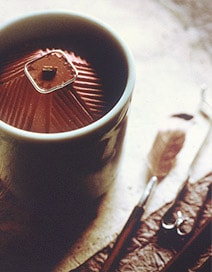
The Beauty of KODO
The origin of KODO
- The oldest fragrant wood that washed ashore
- Incense culture in Kyoto and Kamakura and the birth of KODO
- During the Edo period (1603-1867), incense became popular not only among warriors
- Japanese "KODO" Spreading around the world
The oldest fragrant wood that washed ashore
It was about 1,400 years ago. A single fragrant tree drifted ashore on Awaji Island.
In the fourth month of summer in the third year of Emperor Suiko's reign, Jinsui (aloeswood) drifted ashore on Awaji Island. The islanders did not know the fragrance was there, but they mixed it with firewood and burned it on the hearth, and the fragrance was so strong that it was presented as a symbol of the island's greatness.
(Nihon Shoki)
This is Japan's oldest document on fragrant wood, which simply translates to [An islander who did not know the value of fragrant wood picked it up, burned it with firewood, and found it smelled so good that he presented it to the imperial court.] This episode is reminiscent of the islanders' surprise and panic. This jinsui is aloeswood. It is said that a tree of the Thymelaeaceae family has become resinous through the action of fungi and other agents. The name is derived from the fact that while fresh wood floats on water, aloeswood is full of resin and has a high specific gravity, which causes most of it to sink in water.

Incense culture in Kyoto and Kamakura and the birth of KODO
With the arrival of Buddhism, incense developed as one of the indispensable articles for Buddhist ceremonies. In the Heian period (794-1185), incense was refined as an elegant culture and custom of the nobility and the court, away from Buddhist rituals. In addition to the daily burning of “Soradaki” in the room, incense was also used as a kind of entertainment, which added color to the elegant and gorgeous days of the Heian aristocrats. The following period from the Kamakura period to the Muromachi period is commonly referred to as the Sengoku Ransei (Warring States Period). During the wild battles, warlords cherished and enjoyed incense and tea.
The precious aromatic woods used for KODO were imported then, as they are now, but it was the Japanese people's unique and wonderful sensibility that sublimated them into the culture of “KODO”. KODO was established in the Muromachi period (1336-1573). Ashikaga Yoshimasa ordered the court nobles Sanjonishi Sanetaka and Shino Soushin to compile a set of manners and rules, creating the foundation of KODO as we know it today.
During the Edo period (1603-1867), incense became popular not only among warriors
During the Edo period (1603-1867), incense became popular not only among warriors, feudal lords, and aristocrats, but also among wealthy farmers and townspeople, and Monko appeared in novels by Saikaku and Tanehiko. Kyara became synonymous with the finest quality during this period, and it is said that when Dutch ships arrived at Dejima in Nagasaki, feudal lords from all over the world competed to obtain the finest fragrant wood. Thus, KODO has played an indispensable role in Japanese spiritual culture as a form of culture and enjoyment for the general populace.
Japanese "KODO" Spreading around the world
However, with the arrival of the Meiji period (1868-1912), the Japanese tradition of KODO declined drastically, along with the movement to abolish Buddhism and the opening of Japan to the rest of the civilization. Despite these difficult times, KODO has been preserved and passed on by people with rich hearts and minds. Today, the true value of KODO, a uniquely Japanese traditional culture, is being reevaluated, with younger generations in Japan increasingly interested in KODO and its integration with kimono and Japanese architecture as part of a broader “Japanese culture” that is becoming more integrated into daily life. Furthermore, KODO is also attracting international attention, and events are being held overseas, signaling the arrival of a “new KODO period.

